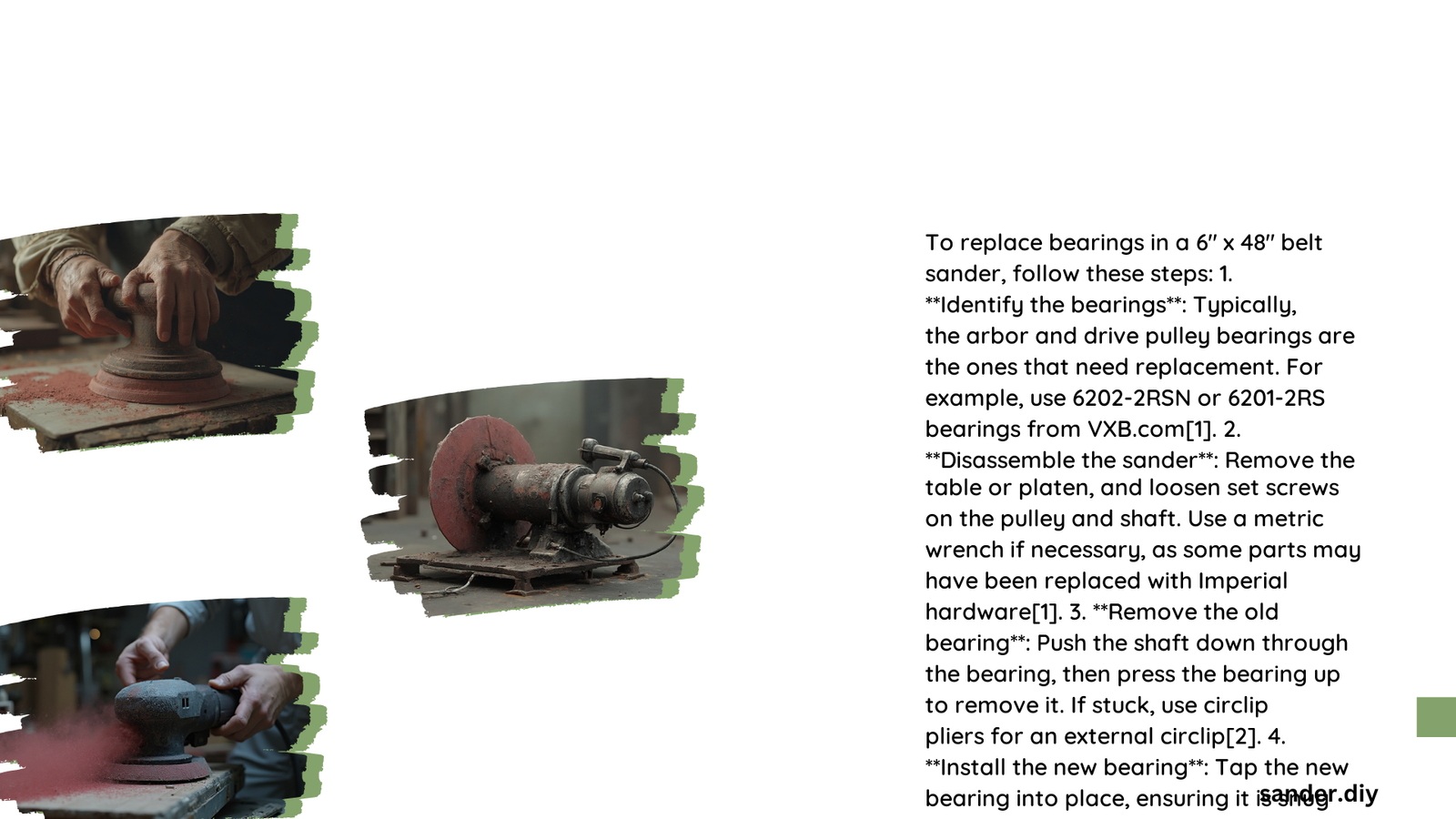Belt sander bearing replacement is a crucial maintenance task that ensures optimal performance and longevity of your power tool. This process involves removing worn-out bearings and installing new ones to maintain smooth operation and prevent damage to the sander. Proper replacement requires knowledge of bearing types, sizes, and installation techniques specific to belt sanders. This guide provides detailed information on identifying, selecting, and replacing bearings in belt sanders, along with maintenance tips to extend their lifespan.
What Are the Common Sizes of Belt Sander Bearings?
Belt sander bearings come in various sizes depending on the make and model of the tool. Here are some common dimensions:
- Shopsmith Belt Sander: 5/8 inch x 35 mm x 11 mm (driver drum shaft)
- Backup bearings: 7mm x 22mm x 7mm (OEM part number 627ZZ)
- General Industrial Bearings: R8 bearing (1/2\” ID, 1.125\” OD, 0.312\” width)
It’s crucial to measure your existing bearings or consult your sander’s manual for exact specifications.
Which Types of Bearings Are Used in Belt Sanders?

Belt sanders typically use three main types of bearings:
- Shielded Bearings
- Metal shield on one or both sides
- Suitable for dusty environments
-
Moderate protection against contaminants
-
Sealed Bearings
- Fully sealed with rubber or plastic
- Ideal for harsh environments
-
Superior protection against moisture and debris
-
Ceramic Bearings
- Ceramic balls instead of steel
- Improved corrosion resistance
- Lower friction and higher speed capabilities
How to Replace Belt Sander Bearings Step-by-Step?
Follow these steps for a successful belt sander bearing replacement:
- Gather necessary tools:
- Bearing puller or hydraulic press
- Socket set or wrench set
- Safety glasses and gloves
- Clean rags
-
Lubricant (if required)
-
Ensure safety:
- Unplug the sander
- Wear protective gear
-
Work on a clean, stable surface
-
Disassemble the sander:
- Remove covers and guards
-
Locate the bearings
-
Remove old bearings:
- Use a bearing puller or press
-
Apply heat or penetrating oil if stuck
-
Clean the housing thoroughly
-
Install new bearings:
- Align carefully
-
Press into place using appropriate tools
-
Reassemble the sander
-
Test for proper operation
What Are the Specific Challenges in Belt Sander Bearing Replacement?
- Stuck Bearings
-
Solution: Apply heat or use penetrating oil
-
Alignment Issues
-
Solution: Ensure proper alignment during installation
-
Over-tightening
- Solution: Follow manufacturer’s torque specifications
How to Properly Install and Maintain Belt Sander Bearings?
Installation Tips:
- Follow torque specifications
- Use alignment techniques for proper fit
- Apply recommended lubricant
Maintenance Practices:
- Regular Inspection
-
Check for noise, vibration, or excessive heat
-
Cleaning
-
Keep bearing area free of debris
-
Lubrication
- Follow manufacturer’s recommendations
What Tools Are Essential for Belt Sander Bearing Replacement?
| Tool | Purpose |
|---|---|
| Bearing Puller | Removes old bearings |
| Hydraulic Press | Alternative for bearing removal/installation |
| Socket Set | For disassembly and reassembly |
| Safety Glasses | Protects eyes from debris |
| Gloves | Provides hand protection |
| Clean Rags | For cleaning and wiping surfaces |
| Lubricant | For proper bearing function (if specified) |
How to Identify When Belt Sander Bearings Need Replacement?
- Unusual Noises
-
Grinding or squealing sounds during operation
-
Excessive Vibration
-
Indicates worn or damaged bearings
-
Reduced Performance
-
Sander not running smoothly or efficiently
-
Visual Inspection
-
Signs of wear, rust, or damage on visible parts
-
Increased Heat
- Bearings running hotter than normal during use
By following these guidelines and addressing the specific challenges of belt sander bearing replacement, you can maintain your tool’s performance and extend its lifespan. Regular maintenance and proper installation techniques are key to ensuring your belt sander operates smoothly and efficiently.
References:
1. Shopsmith Bearings Guide
2. Proper Ball Bearings for Rollers on Homemade Belt Grinders
3. Highland Park Bearing for Model WBS Wet Belt Sander
